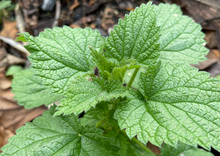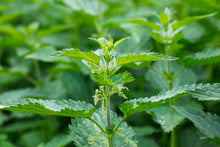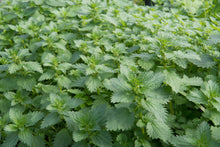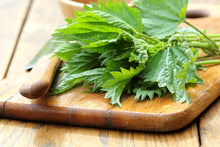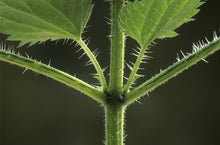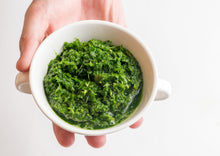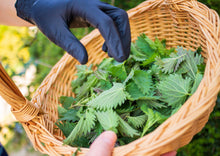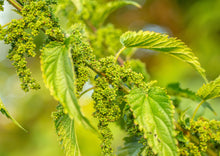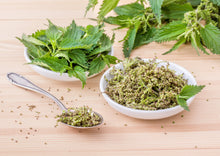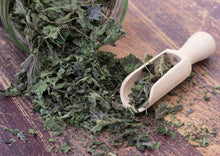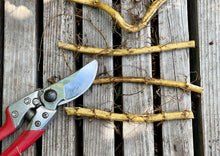
It's not nice to play favorites, but if we had to choose one perennial alternative to annual spinach, the choice is easy ... it's Stinging Nettle! Nettle is nature's multivitamin. Its amazing golden root structure mines deep for vitamins and minerals and pulls them to the surface into its roots, leaves, and seeds. It's one of the most nutrient-dense foods you can add to your diet. This same makes abundance of nutrients also makes nettles an awesome homemade fertilizer. And the best part is, not only is it extremely nutritious, but it's also DELICIOUS! We enjoy the leaves in place of spinach in all our favorite recipes, in pestos, and sprinkle the tasty seeds on top of most of our dishes to enjoy their stress busting superpowers. Every garden needs a nettle patch. Food, medicine, fertilizer, and garnish in one. Can you tell we like it a little bit? :) (Urtica dioica)
This is our wild-crafted stinging nettle that has maximum potency for medicine. It is our full-sting variety. For use for vegetable production, you may want to consider our Less-Sting Nettle variety, which has virtually no stings on the leaves
Why We Love It
Here are some of the reasons why we love Nettle...
1) NUTRIENT DENSE - Stinging nettle is loaded with vitamins A, K, C, iron, calcium, potassium, and protein. It helps build blood and many think of it as nature's multivitamin.
2) AMAZING FERTILIZER - All of the nutrients that are in nettle that are so good for our bodies are also amazing for our gardens. You can use nettle to make homemade fertilizer. It combines really well with comfrey and horsetail.
3) HOME FOR BUTTERFLIES, LADY BEETLES AND APHIDS - Nettle is an insectary plant, which means that it is home for many beneficial insects in your garden. These beneficial insects will help your garden by competing with pests.
4) POTENT MEDICINE - Nettle is famous for alleviating anemia, stimulating hair growth, promoting circulation, treating allergies, and alleviation arthritis and inflammation. The seeds are extremely nourishing to the adrenals and help you adapt more effectively to stress.
How to Grow It
Here's how to grow Nettles:
| SUN | SUN to PART SHADE |
| MOISTURE | DROUGHT TOLERANT BUT PREFERS MOIST ZONES |
| GROWING ZONES | USDA ZONES 3-10 (Not sure? Find your growing zone here) |
| SIZE | 3-7 FEET TALL & WIDE |
| GROWING |
From Seed: Rake soil to prepare for seeding. Nettles love nitrogen-rich soil. Sprinkle seeds on soil surface. Press into soil. Keep moist and in the light. Nettle seeds germinate quickly when it's warm out and slowly when it's cool. Thin to 1-2 feet apart. Winter Sowing is the easiest way to start these seeds. Here's a seed-starting tutorial for you. You won't believe how easy it is! From Rhizome: Bury rhizome directly in the garden once you can access the soil, or in the fall weeks before the first frost, 4-6'' deep and water in. Nettle will begin to sprout in the spring, harvest leaves frequently for best production. Once they begin to go to seed stop harvesting the leaves and wait for the seeds to mature for harvest and use. PRO TIP: Nettle likes to be a little bossy if it's happy. It spreads via rhizomes in the ground, so let its adventurous nature work for you and plant it at the edges of your garden or food forest where they have room to expand. Make sure to use thick gloves when you harvest. The stinging nature of nettles is eliminated by just a few minutes of cooking. In order to make seeds, you need both a male and female plant. If you want seeds, we suggest you order at least 3 rhizomes. |
How to Harvest & Use It
Nettle is so delicious and so nutrient-dense. That's why we love it so much. You can use the leaves in place of spinach in any recipe. The seeds are a delicious and healthy replacement for sesame seeds. And the roots make powerful medicine. We dry the leaves and then sprinkle them into soups, stir fries, and other dishes throughout the year as a natural multivitamin.
All that you need to enjoy nettle is to respect its powers. Its stinging power is also why it makes it a powerful medicine for inflammation and arthritis, but make sure to wear thick gloves when you harvest nettles. The leaves are best harvested in the Spring and can be harvested repeatedly until the seeds start to develop in the Summer. The seeds are best harvested in the Fall when they start to drop into their leaves. The roots can be dug in the Fall. You can use nettles to make fertilizer any time of year. The stinging nature of nettles is eliminated by just a few minutes of cooking.
STINGING NETTLE PESTO RECIPE
Here's a great recipe from our friends at Mountain Rose Herbs for a delicious pesto.
Ingredients:
- 2-4 Tbsp. organic hulled hemp seeds, pine nuts, walnuts, or other nut/seed of your choice
- 4-5 oz. fresh nettle leaves and stems (or 2 cups dried organic nettle leaf)
- 2-3 oz. grated organic Parmigiano Reggiano
- 1/2-1 tsp. finely ground sea salt or other salt of your choosing, or to taste
- 1-2 peeled organic garlic cloves (or 1-2 tsp. organic garlic powder), or to taste
- 3/4 cup organic extra virgin olive oil, or to desired consistency
Directions: Toast hemp seeds or other nut/seed on a hot frying pan for about 1 minute, or until golden brown (but not burned). Remove from heat. Bring large pot of water to boil. Set aside large bowl of ice water. Once water boils, place nettle into boiling water using tongs. If using fresh nettle, be careful not to touch with bare hands! Blanch nettle for 1 to 2 minutes. This will remove the sting. Remove nettle from boiling water and place in bowl of ice water to retain its bright, green color. Turn off heat on boiling water, but reserve the water for boiling your pasta, if using the pesto as a pasta sauce. It can also make for a nutritious tea. Once nettle has cooled (about 5 minutes), remove nettle by the handful and squeeze out water. Place squeezed nettle on a kitchen towel to dry. Combine nettle and remaining ingredients (except olive oil) in a food processor or blender. Blend until ingredients are well mixed and form a paste. With the blender or food processor running, slowly pour in oil until desired consistency is reached. Your pesto is now complete! Use immediately, refrigerate, or freeze in ice cube trays.
Nettles is an amazing super food. Learn more about its power as an adaptogenic tonic food that you can benefit from incorporating into your diet. Rosemary Gladstar is a world-renowned herbalist and has made a great video about nettles and other adaptogenic herbs:
Here's a video on how to use nettles to make homemade fertilizer:











